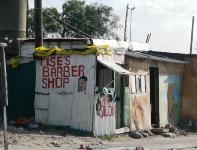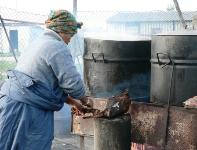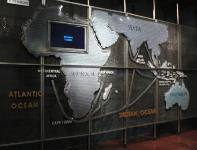

South Africa's
Disturbing Past...
Disturbing Past...
A map showing where the slaves came from
.
.
In a shanty town.
Cooked sheep's head, anyone?
July 3, 2006
Slave Lodge
I visited the Slave Lodge today and came away with some of the history of South Africa. I took down some notes when I was
there. The pieces of information don’t totally tie together so I am just putting them down as bullet points…
********************
July 22, 2006
Township Tour
Wow. Let me just start by saying that I learned a lot today.
Lori and I did a township tour. Unfortunately, neither of us really felt like we got the full experience. In any case, our guide,
Havelin (who was self-described as ‘colored’), gave us a lot of information as he has seen the changes take place first-hand.
Am I embarrassed to say that I did not know a lot of what I found out today? Yes. I remember hearing a lot about Nelson
Mandela in the 8th grade. I am sure it was even explained to us about what was going on in South Africa and how huge of a
deal it was. Call me an ignorant 13-year old…but I think I probably barely retained any of that news seeing that it was
happening ‘so far away’.
To be honest, it blows me away that apartheid was alive and kicking while I was a kid. It was in my lifetime. Havelin painted a
bit of a picture for us…
We passed the Cape Town train station. Now it says ‘Entrance’. As recently as 1990, it said ‘Entrance: Whites’. There was
another entrance on the side of the building that read ‘Entrance: Non-Whites’. It goes without saying that there were different
train cars for both as well.
District 6 was one of the most devastated areas in this city. Everybody was driven out. Everything (with the exception of
churches, mosques, etc.) was bulldozed. Today things are starting to be rebuilt but, for the most part, it is still open land. The
people that lived here were sent to either a black township or a colored township depending on what category they fell into.
The goal was to have a ‘white’ Cape Town. In fact, whites who moved to South Africa (but weren’t South Africans) had more
rights than colored and black South Africans. They were allowed to vote (as long, of course, as they voted for the National
Party). Everybody was given a national identity number. The last three numbers represented what race you were. Havelin
told us that they ran a few tests to determine if a person was ‘black’ or ‘colored’. There was a ‘pencil test’ where they would
stick a pencil in their hair. If it eventually came out after a few shakes, you were ‘colored’. If it didn’t come out, you were
‘black’. They also took measurements of people’s noses and butts to figure this out. Another piece of information that I found
interesting was that while Chinese people were considered ‘colored’, Japanese people were considered ‘white’.
We visited the Malay Quarter (which was surprisingly spared during apartheid) which is a predominantly Muslim part of Cape
Town. It is also an extremely bright and colorful neighborhood.
From their, we made our way through District 6 and then to the first black township: Langa. During apartheid, whites made
official language in schools Afrikaans. Blacks had a problem with this as they knew English and their own tribal language. The
whites clearly did not care. In 1976 there were student demonstrations where the blacks and colored put their voices out
there. The government initially tried to put an end to this by using tear gas. Later they went to extreme measures by bringing
the army in. June 16th is ‘National Youth Day’ to remember the kids that were killed.
From there, we went to the shanty town of Khayelitsha. What a change from the township! The buildings in the township
were…well…buildings. In the shanty town, the structures looked like they could have been held together by staples. There is a
project going on currently that is working to put up actual buildings to replace the current shanty towns in Cape Town. They
will then look more like the townships. We saw an area where this had already been done. Havelin told us that the goal was to
have it done by 2010. Ummm…if you saw the size of the shanty towns, you would agree with me when I say that seems like a
highly optimistic time of completion. Especially if you factor in how much work they still need to do for the World Cup in 2010
(our taxi driver more than shared these sentiments, as well).
South Africa went bankrupt in the 1980s because other countries were no longer doing business with them. Barclay’s, for
example, was forced to withdraw from South Africa because so many people were closing accounts. The world was beginning to
rally around the idea that things needed to change in South Africa.
When Mandela was freed (after spending 18 out of 27 years on Robben Island), this was when apartheid was abolished
unconditionally. This day (February 11, 1990) is known as ‘Freedom Day’.
Apartheid lasted for thirty years from 1960 through 1990.
However, 1990 through 1994 was a time of uncertainty. There could have been a civil war because everybody (tribes, etc)
wanted a piece of the freedom. Mandela encouraged people to reach out and forgive. Without a doubt, he is the reason why
South Africa is the way it is today. In 1994, South Africa was officially born. This is when people became ‘South African citizens’
versus being ‘coloreds’ or ‘blacks’. Of course many whites are still racist. And many blacks and coloreds (understandably) could
not forgive the whites. But overall, things have shown a positive change.
The slogan of Cape Town is now a ‘City of People, not Races’.
Slave Lodge
I visited the Slave Lodge today and came away with some of the history of South Africa. I took down some notes when I was
there. The pieces of information don’t totally tie together so I am just putting them down as bullet points…
- In 1652 Cape became a colony. The problem was that there wasn’t the labor needed for a colony. This is what brought
about the need for slaves.
- Slaves were brought to the Cape from Indonesia, India-Ceylon, Madagascar and Mozambique (this was in contrast to the
route used by the transatlantic slave trade which brought Africans to the Americas and Caribbean).
- Ships were sent by the VOC (Dutch East India Company) authorities.
- Slaves were denied basic rights like family and marriage. Kids were taken away from their mothers at any time.
- In 1658 slaves were first introduced to the Cape. 76 out of 250 died on the voyage. They were bound for the Trans-
Atlantic but ended up being captured by the Dutch who then brought them to the Cape.
- Upon arrival, new names were given based on bible, calendar months, mythology, etc. and including place where they
came from. This stripped them of their identity.
- The ‘Middle Passage’ is known as largest loss of life in a period of time.
- Slaves worked from sunrise to sunset; they were locked away in lodge during all other hours.
- Slaves got one new outfit per year. Slaves were roped up in the times that they weren’t working. Slaves weren’t allowed
to wear shoes.
- The Slave Lodge was built in 1679. In 1811 all slaves were moved to alternate places and the Slave Lodge became
government offices.
- From the years 1711-1795, slaves outnumbered colonists.
- The British abolished slavery in the colonies in 1807.
- Cape Town would not be what it is today without the work of the slaves. They played a major role in the language, crafts,
cuisine, religion, architecture, clothing, etc. In addition they were craftsmen, masons, blacksmiths, carpenters, etc.
- The motto of the Slave Lodge: “History of human wrongs working to build culture of human rights.”
********************
July 22, 2006
Township Tour
Wow. Let me just start by saying that I learned a lot today.
Lori and I did a township tour. Unfortunately, neither of us really felt like we got the full experience. In any case, our guide,
Havelin (who was self-described as ‘colored’), gave us a lot of information as he has seen the changes take place first-hand.
Am I embarrassed to say that I did not know a lot of what I found out today? Yes. I remember hearing a lot about Nelson
Mandela in the 8th grade. I am sure it was even explained to us about what was going on in South Africa and how huge of a
deal it was. Call me an ignorant 13-year old…but I think I probably barely retained any of that news seeing that it was
happening ‘so far away’.
To be honest, it blows me away that apartheid was alive and kicking while I was a kid. It was in my lifetime. Havelin painted a
bit of a picture for us…
We passed the Cape Town train station. Now it says ‘Entrance’. As recently as 1990, it said ‘Entrance: Whites’. There was
another entrance on the side of the building that read ‘Entrance: Non-Whites’. It goes without saying that there were different
train cars for both as well.
District 6 was one of the most devastated areas in this city. Everybody was driven out. Everything (with the exception of
churches, mosques, etc.) was bulldozed. Today things are starting to be rebuilt but, for the most part, it is still open land. The
people that lived here were sent to either a black township or a colored township depending on what category they fell into.
The goal was to have a ‘white’ Cape Town. In fact, whites who moved to South Africa (but weren’t South Africans) had more
rights than colored and black South Africans. They were allowed to vote (as long, of course, as they voted for the National
Party). Everybody was given a national identity number. The last three numbers represented what race you were. Havelin
told us that they ran a few tests to determine if a person was ‘black’ or ‘colored’. There was a ‘pencil test’ where they would
stick a pencil in their hair. If it eventually came out after a few shakes, you were ‘colored’. If it didn’t come out, you were
‘black’. They also took measurements of people’s noses and butts to figure this out. Another piece of information that I found
interesting was that while Chinese people were considered ‘colored’, Japanese people were considered ‘white’.
We visited the Malay Quarter (which was surprisingly spared during apartheid) which is a predominantly Muslim part of Cape
Town. It is also an extremely bright and colorful neighborhood.
From their, we made our way through District 6 and then to the first black township: Langa. During apartheid, whites made
official language in schools Afrikaans. Blacks had a problem with this as they knew English and their own tribal language. The
whites clearly did not care. In 1976 there were student demonstrations where the blacks and colored put their voices out
there. The government initially tried to put an end to this by using tear gas. Later they went to extreme measures by bringing
the army in. June 16th is ‘National Youth Day’ to remember the kids that were killed.
From there, we went to the shanty town of Khayelitsha. What a change from the township! The buildings in the township
were…well…buildings. In the shanty town, the structures looked like they could have been held together by staples. There is a
project going on currently that is working to put up actual buildings to replace the current shanty towns in Cape Town. They
will then look more like the townships. We saw an area where this had already been done. Havelin told us that the goal was to
have it done by 2010. Ummm…if you saw the size of the shanty towns, you would agree with me when I say that seems like a
highly optimistic time of completion. Especially if you factor in how much work they still need to do for the World Cup in 2010
(our taxi driver more than shared these sentiments, as well).
South Africa went bankrupt in the 1980s because other countries were no longer doing business with them. Barclay’s, for
example, was forced to withdraw from South Africa because so many people were closing accounts. The world was beginning to
rally around the idea that things needed to change in South Africa.
When Mandela was freed (after spending 18 out of 27 years on Robben Island), this was when apartheid was abolished
unconditionally. This day (February 11, 1990) is known as ‘Freedom Day’.
Apartheid lasted for thirty years from 1960 through 1990.
However, 1990 through 1994 was a time of uncertainty. There could have been a civil war because everybody (tribes, etc)
wanted a piece of the freedom. Mandela encouraged people to reach out and forgive. Without a doubt, he is the reason why
South Africa is the way it is today. In 1994, South Africa was officially born. This is when people became ‘South African citizens’
versus being ‘coloreds’ or ‘blacks’. Of course many whites are still racist. And many blacks and coloreds (understandably) could
not forgive the whites. But overall, things have shown a positive change.
The slogan of Cape Town is now a ‘City of People, not Races’.
